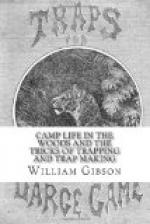The average length of the “Bark,” as used by trappers, is about twelve feet, but they may be constructed of any desired dimensions, to the length of forty feet. A canoe of this size will carry fifteen or twenty persons, and may be transported with ease upon the shoulders of two strong men. The smaller size, above mentioned, is capable of carrying two persons, and is a light load for a single man.
[Illustration]
In constructing the bark canoe the first requisite is the gunwale, or upper framework. This should consist of four strips of cedar, ash, or other light, strong wood; two for each side of the boat. For an ordinary sized canoe, their length should be about twelve feet, width one inch, and thickness one-quarter of an inch. They should be tied together in pairs at the ends, and the two pairs then joined at the same place. The object of [Page 262] these pieces is to give strength and form to the canoe, and to offer a firm security for the edges of the bark, which are secured between them. The gunwale being prepared, we are now ready for the birch bark. The bottom of a well made canoe should be in one large piece, as our illustration indicates, if possible. Select some large tree with the trunk free from knots or excrescences. Mark off as great a length as possible, and chop a straight cut in the bark through the whole length of the piece, after which it should be carefully peeled from the wood. It will sometimes happen, where large birches exist in perfection, that a single piece may be found of sufficient size for a whole canoe, but this is rather exceptional, and the bottom is generally pieced out, as seen in our drawing. This piecing may be accomplished with an awl and Indian twine, or by the aid of a large needle threaded with the same, sewing with an over-and-over stitch around the edge of each piece. Use as large pieces as are attainable, and continue to sew them on until the arca of bark measures about four and a half feet in width by twelve feet in length, the dark colored sides of the bark all facing the same way. Next select a fiat piece of ground, and mark off a distance of ten feet, or two feet less than the length of the gunwales. At each end of the space two tall stakes should be driven into the ground about three inches apart. Now turn the bark on the ground with its white side uppermost, and fold it loosely and evenly through the long centre. In this folded condition it should now be lifted by the upper edge and set between the stakes. There will then be about a foot of projecting bark beyond each pair of stakes. These ends should now be covered by folding another piece of bark over them, sewing the edges firmly to the sides of the rude form of the canoe, which now presents itself. When this is done, each end should be supported on a log or stone; this will cause the bottom line to sink downwards at about the proper curve. We are now ready for the gunwale. Lay it in the proper position, fitting the edges of the bark between




